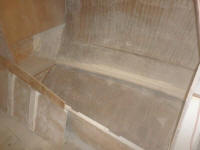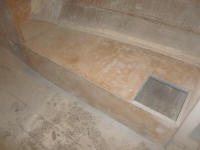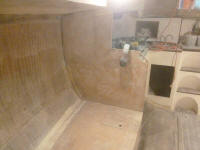
110 Cookson Lane | Whitefield, ME 04353 | 207-232-7600 | tim@lackeysailing.com
I continued working my way through the boat, sanding and cleaning up all surfaces as I went. On this day, I began on the starboard side of the saloon, and sanded the raw fiberglass (original laminate) hull side and surrounding areas, including within the hanging locker to the extent possible and required. I temporarily removed the settee platform and vertical panel enclosing the locker beneath so I could clean up and sand the hull in that area, beneath where the water tank had been located.
I think my camera had dust in the lens, so the first round of photos is rather indistinct.
After sanding both sides of the plywood platform pieces and reinstalling them with a few screws, I continued with the lower port settee face, removing the paint that was loose and peeling to begin with. Meanwhile, I lightly sanded the port side of the teak bulkhead to prepare it for whatever might come next; I doubted that this surface would be exposed in the new interior.
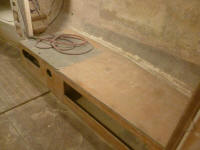
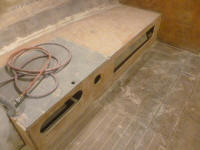
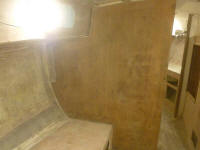
The starboard main chainplate knee, located within the after portion of the hanging locker/passageway cabinet, appeared at initial inspection to be sound, and for the moment I was satisfied enough to leave it alone. It was too long a reach from either the inboard side of the cabinet or from beneath to truly work in the top part of this space in its current configuration. Additional inspection or knee replacement would require removal of the small bulkhead just aft, which I'd been looking at for some time. However, this bulkhead was secured to the passageway bulkhead with many nails and screws, incorporating various drawer supports, and removal, unless necessary, wasn't straightforward enough to proceed with on a whim. For the moment, I left this area alone.

Throughout this process, in all areas of the boat, I continued to remove section after section of anemic tabbing that yielded to the most basic hand pressure. None of this came as a surprise, as I'd been prepared for this since first exposing any of the boat's structure during initial interior removal and before.
The bulkheads and interior structures in this boat were extremely lightly secured with this minimalist approach to tabbing, and what was there had failed in most cases. It was unclear whether the builder thought that their nifty cored hull structure didn't require the support of internal bulkheads, but none of the interior structure on this particular boat was installed in such a way as to contribute to the rigidity of the hull or deck. Bulkheads were vaguely cut to shape, with two and three-inch gaps between the plywood and the adjacent hull or deck, and then single layers of lightweight, sporadic fiberglass were installed to simply tack these structures in place.
Installing sound, secure tabbing to fasten the bulkheads and provide needed stiffness to the overall hull and deck system would be a key improvement to the overall structure of the boat, and, with generally good access everywhere, this would be a generally straightforward task. Where possible I tried to prepare the mating surfaces with new tabbing in mind, removing existing paint or gelcoat to bare (or nearly bare) laminate to ensure good future bonds, but in some areas I knew I'd have to come back later with this specific task in mind.
Next, I opened up the galley areas as much as possible and sanded the hull and bulkheads within. Again, there were several sections of pathetic tabbing that I removed as I went. Not only was the tabbing ugly--unkempt masses of ragged mat fibers--but where it wasn't already loose from premature failure, I could easily loosen it with simple hand pressure from a chisel. While I was there, I sanded the paint off the bulkheads within and around the galley, exposing more of the paper-coated plywood used throughout the interior. Note that for the moment, I left the galley countertop and sink in place, mainly for tool storage and convenience, but this would be revamped or replaced later in the process.

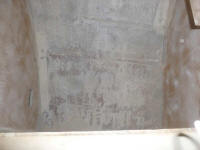

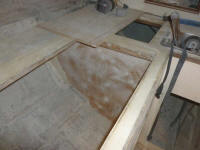
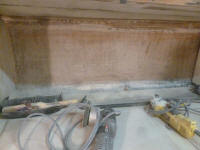
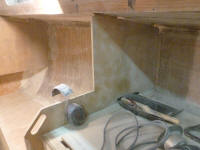
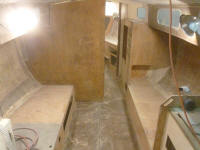
The main cabin overhead, with its blobs of of adhesive, foam, and other hanging detritus, seemed like a good chore to leave to the end of the day. I sanded the entire area, removing the foam and wood remnants and preparing the surface for new installations later, but didn't try to remove all the old gray adhesive. Later, I might need to remove more of this material to allow for new support strips to lay flat, but I'd work that out when the time came.

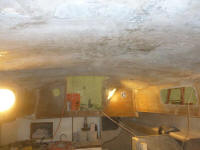
Total Time on This Job Today: 6 hours
